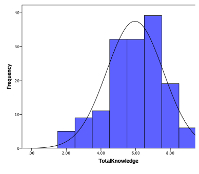Midwives’ Knowledge, Attitude and Use of Health Management Information System in Obstetrics and Gyneacology Departments in Teaching Hospitals in Abia State
DOI:
https://doi.org/10.60787/tnhj.v23i2.681Keywords:
Knowledge, attitude, health management information system, HMIS, midwives, teaching hospital, Abia StateAbstract
Background: Effective use of Health Management Information Systems (HMIS) is an imperative in delivering midwifery services. This study assessed the knowledge, attitude, and use of HMIS among midwives in obstetrics and gynaecology departments in two teaching hospitals in Abia State.
Methods: This cross-sectional study involved the administration of structured questionnaires to 161 respondents. Knowledge and attitude towards HMIS were computed from the summated scores of a multi-dimensional structured questionnaire and categorized as good (>70%), fair (50-69.9%) and poor (<50%). Descriptive and inferential statistics were conducted using the Statistical Package for the Social Sciences, Version 25. Ordinal logistics regression was used to determine factors associated with the knowledge and attitude of midwives toward HMIS. The odds ratio, 95% confidence intervals and the p-value were reported with p-value <0.05 considered significant.
Results: More respondents were female (88.8%), had good knowledge (41.8%) and positive attitudes (46.4%) towards HMIS. Midwives aged <25 years showed significantly poorer attitudes towards HMIS compared to those ≥40 years (OR=0.44; 95%CI:0.24, 0.81), p < 0.0001). Same was observed for those with years of experience between 11 – 15 years compared to those ≥15 years (OR = 0.44; 95%CI:0.27, 0.73; p=0.001).
Conclusion: Less than half of the midwives reported good level of knowledge and positive attitude towards using HIMS. The influence of age and years of experience on midwives’ attitude should be explored in interventions to improve the use of HMIS in teaching hospitals.
Downloads
References
World Health Organization. Developing health management information systems: a practical guide for developing countries. WHO Regional Office for the Western Pacific; 2004.
World Health Organization. The world health report 2000: health systems: improving performance. World Health Organization; 2000.
Ogaji DS, Anyanwu CE. Implementing electronic health record in a public health facility in Nigeria: awareness, acceptance and concerns among critical stakeholders. Int. J. Electronic Healthcare. 2021; 11(4):364 –377.
Hussain R, Ali W, Sohaib M. Perceptions of Physicians Regarding Implementation of Hospital Management Information Systems in a Tertiary Setting Hospital of a Developing Country. Cureus. 2021;13(10).
Fakhrzad M, Fakhrzad N, Dehghani M. The role of electronic health records in presenting health information. Interdisciplinary Journal of Virtual Learning in Medical Sciences. 2012;2(4):31-40.
Moradi G, Sarbaz M, Kimiafar K, Shafiei N, Setayesh Y. The role of hospital information system on Dr Sheikh Hospital performance promotion in Mashhad. Health Information Management. 2008;5(2):159-166.
Doupi P, van der Lei J. Design and implementation considerations for a personalized patient education system in burn care. International journal of medical informatics. 2005;74(2-4):151-7.
Wirth M. Professionals with delivery skills: backbone of the health system and key to reaching the maternal health Millennium Development Goal. Croatian medical journal. 2008;49(3):318-33.
Federal Ministry of Health. National Health Management Information System (NHMIS): Policy, Programme, Strategic Plan of Action. Federal Ministry of Health, Department of Planning, Research and Statistics, National Health Management Information System Unit, 1996.
Chatterjee P, Gupta A, Subramanian SV. Can administrative health data be used to estimate population levelbirth and child mortality estimates? A comparison of India's Health Information Management System data with nationally representative survey data. SSM-Population Health. 2022;19.
Jolivet RR, Moran AC, O’Connor M, Chou D, Bhardwaj N, Newby H, Requejo J, Schaaf M, Say L, Langer A. Ending preventable maternal mortality: phase II of a multi-step process to develop a monitoring framework, 2016–2030. BMC pregnancy and childbirth. 2018; 18:1-3.
Alinnor EA, Ogaji DS. Physicians’ knowledge, attitude and practice of clinical audit in a tertiary health facility in a developing country: a cross-sectional study. The Pan African Medical Journal. 2022;43.
Chi BH, Vwalika B, Killam WP, Wamalume C, Giganti MJ, Mbewe R, Stringer EM, Chintu NT, Putta NB, Liu KC, Chibwesha CJ. Implementation of the Zambia electronic perinatal record system for comprehensive prenatal and delivery care. International Journal of Gynecology & Obstetrics. 2011;113(2):131-6.
Tundia NL, Kelton CM, Cavanaugh TM, Guo JJ, Hanseman DJ, Heaton PC. The effect of electronic medical record system sophistication on preventive healthcare for women. Journal of the American Medical Informatics Association. 2013;20(2):268-76.
Shaw E, Howard M, Chan D, Waters H, Kaczorowski J, Price D, Zazulak J. Access to web-based personalized antenatal health records for pregnant women: a randomized controlled trial. Journal of Obstetrics and Gynaecology Canada. 2008;30(1):38-43.
Ahmadi M, Sadoghi F, Gohari M, Rangraz Jeddi F. Personal health record, information technology in future health care system: Physicians and nurses’viewpoint. Health Information Management. 2011;8(1).: 5-17.
Kahouei M, Mohammadi HB, Majdabadi HA, Solhi M, Parsania Z, Roghani PS, Firozeh M. Nurses’ perceptions of usefulness of nursing information system: Module of electronic medical record for patient care in two university hospitals of Iran. Materia Socio-Medica. 2014;26(1) :(1): 30-34.
Sadoughi F, Aminpour F. A Review on the Evaluation Methods of Health Information Systems. Iranian Journal of medical education. 2011;10(5):1077-1086.
Yamane, Taro. (1973), Statistics: An Introductory Analysis. London: John Weather Hill, Inc.
Chaokromthong K, Sintao N. Sample size estimation using Yamane and Cochran and Krejcie and Morgan and green formulas and Cohen statistical power analysis by G* Power and comparisions. Apheit International Journal. 2021. 24;10(2):76-86.
Nachinab GT, Yakong VN, Asumah MN, Ziba FA, Antwi-Adjei H, Benewaa MA, Aidoo A. Experiences of women receiving reproductive health services from male midwives: a qualitative study in Bole District, Savannah Region of Ghana, West Africa. PAMJ-One Health. 2022;7(30).
Amir SK. Assessment of Knowledge, Attitude and Practices towards Heath Management Information System (HMIS) Data Use at Health Facility level among Health Care Providers. A case of Geita District Council (Doctoral dissertation, The Open University of Tanzania).
Endriyas M, Kawza A, Alano A, LemangoF. Quality of medical records in public health facilities: A case of Southern Ethiopia, resource limited setting. Health Informatics Journal. 2022;28(3):14604582221112853.
Anikwe CC, Ifemelumma CC, Ekwedigwe KC, Ikeoha CC, Onwe OE, Nnadozie UU. Correlatesof patients’ satisfaction with antenatal care services in a tertiary hospital in Abakaliki, Ebonyi State, Nigeria. The Pan African Medical Journal. 2020;37. https://doi.org/10.11604/pamj.2020.37.73.24597
Evans C, Robertson W. The four phases of the digital native’sdebate. Human Behavior and Emerging Technologies. 2020;2(3):269-77.
ShekellePG, Morton SC, Keeler EB. Costs and benefits of health information technology. Evidence report/technology assessment. 2006; 1(132):1-71.https://doi.org/10.23970/AHRQEPCERTA132
Addo K, Agyepong PK. The effects of information and communication technology on health service delivery at Tafo Government Hospital. E-Health Telecommunication Systems and Networks. 2020; 14;9(3):33-48. doi: 10.4236/etsn.2020.93003.
Ngusie HS, Ahmed MH, Kasaye MD, Kanfe SG. Utilisation of health management information and its determinant factors among health professionals working at public health facilities in North Wollo Zone, Northeast Ethiopia: a cross-sectional study. BMJ open. 2022;12(4): e052479.
Kasambara A, Kumwenda S, Kalulu K, Lungu K, Morse T, Beattie T, Masangwi S, Ferguson N. Problems associated with the health management information system at district level in southern Malawi. Malawi Medical Journal: The Journal of Medical Association of Malawi. 2016; 22:1-20.

Downloads
Published
How to Cite
Issue
Section
License
Copyright (c) 2023 Journal and Publisher

This work is licensed under a Creative Commons Attribution-NonCommercial-NoDerivatives 4.0 International License.
The Journal is owned, published and copyrighted by the Nigerian Medical Association, River state Branch. The copyright of papers published are vested in the journal and the publisher. In line with our open access policy and the Creative Commons Attribution License policy authors are allowed to share their work with an acknowledgement of the work's authorship and initial publication in this journal.
This is an open access journal which means that all content is freely available without charge to the user or his/her institution. Users are allowed to read, download, copy, distribute, print, search, or link to the full texts of the articles in this journal without asking prior permission from the publisher or the author.
The use of general descriptive names, trade names, trademarks, and so forth in this publication, even if not specifically identified, does not imply that these names are not protected by the relevant laws and regulations. While the advice and information in this journal are believed to be true and accurate on the date of its going to press, neither the authors, the editors, nor the publisher can accept any legal responsibility for any errors or omissions that may be made. The publisher makes no warranty, express or implied, with respect to the material contained herein.
TNHJ also supports open access archiving of articles published in the journal after three months of publication. Authors are permitted and encouraged to post their work online (e.g, in institutional repositories or on their website) within the stated period, as it can lead to productive exchanges, as well as earlier and greater citation of published work (See The Effect of Open Access). All requests for permission for open access archiving outside this period should be sent to the editor via email to editor@tnhjph.com.









